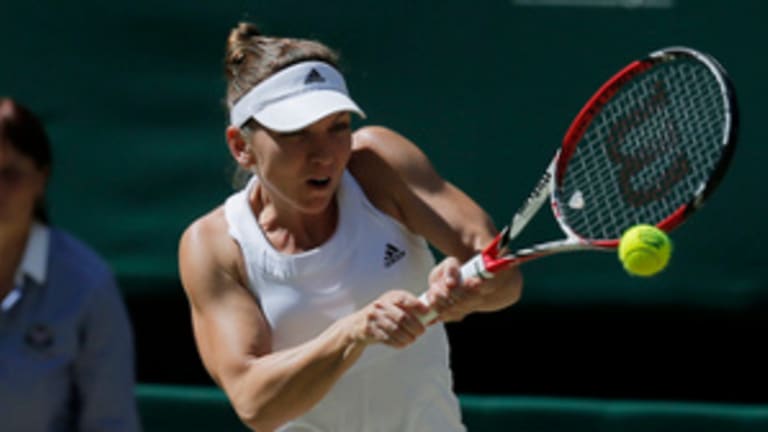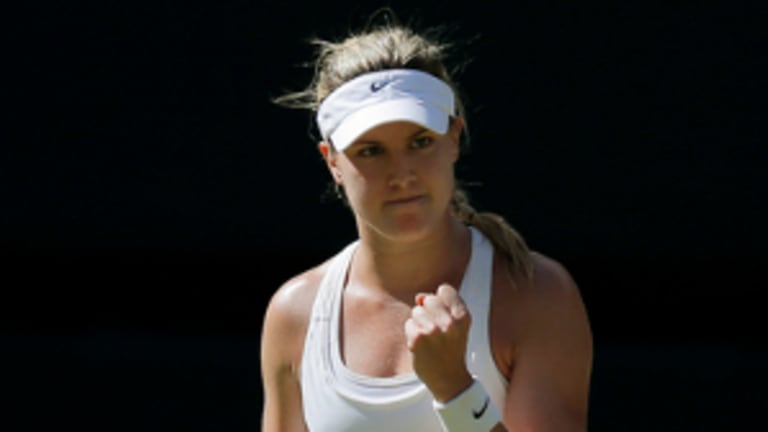The WTA is so attractive and strong these days that when I see of those “Strong is Beautiful” images appear in the background of the tour’s website, I can only wince. Will someone please tell these ladies they don’t have to bend over backwards to impress anyone?
Right now, the WTA boasts a cornucopia of talent. We’re in the midst of a major transition, as some of the most revered female players—women who are also, not coincidentally, vital to the high global profile of the WTA—are aging. They may be aging as gracefully as Tina Turner, but they are getting older. Thankfully, fresh talent is picking up the slack, none more quickly and artfully than Simona Halep and Eugenie Bouchard, who have emerged this year as the twin faces of a WTA youth movement.
Other extremely talented girls, including Garbine Muguruza, Belinda Bencic, Donna Vekic, and Madison Keys, have also announced themselves this season, but none of them has enjoyed anything like the recent success of Halep and Bouchard. It doesn’t hurt that these two are chalk and cheese, despite sharing some similarities in style and critical statistical details.
Halep is a 22-year-old Romanian, two-and-a-half years older than Canada’s Bouchard but still part of the same generation. Bouchard is striking and supremely marketable—which, through no fault of her own, will rub many people the wrong way. Halep is in some ways the anti-Bouchard, but not to the point that it creates an image rivalry. With these two, everybody wins.
Halep started the year with a ranking of No. 11 and bolted to No. 3 after her run to the French Open final. Bouchard, who began the season ranked No. 31, is now just four ticks of the computer behind Halep. She’s the only WTA player to have made the semifinals at every Grand Slam played so far this year, and was last seen taking a beating from Petra Kvitova with grace and composure on Wimbledon’s Centre Court—after dismissing Halep in the semis.
Halep has won two titles so far this year, Bouchard one. Their win-loss record is remarkably close: Halep was 36-10 after winning Bucharest on Sunday; Bouchard is 36-14. Halep is just 5’6” compared to Bouchard’s 5’10”, at nearly identical weights. However accurate those numbers, Halep obviously has a compact but solid, well-muscled body, while Bouchard skews more to the long and lean, like the woman to whom she is frequently compared every which way from Sunday, Maria Sharapova. They have split their two matches, with Halep winning at Indian Wells and Bouchard getting revenge at Wimbledon.
Halep still lives in the town of her birth, Constanta. It seems appropriate, because Halep certainly is the “constant” type—reliable, hard-working, and modest, she’s a thorough professional who also uses her tennis to express an abiding passion for her homeland. She has become something of an icon in Romania, where her father, Stere, a former minor-league football player, owns a dairy-products factory.
The most improved WTA pro in 2013, Halep first came to notice for an unusual reason: At almost 18 years of age, she underwent breast-reduction surgery. It ultimately led to a jump of more than 450 places in the rankings.
The biographical detail is worth mentioning because it’s been critical to Halep’s success, and it flies in the face of the omnipresent theories that there is a specific body type most suited to tennis. So much for the relentless drum of the idea that tennis will evolve to the point where most of the players have comparable physiques.
As Serena Williams has said of Halep, “She serves so well for her height. She has so much power on her serve. That’s actually awesome.”

